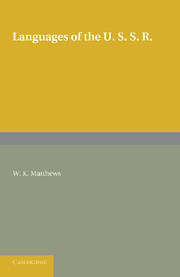Book contents
- Frontmatter
- Contents
- LIST OF ILLUSTRATIONS
- PREFACE
- Map
- Chapter I THE LINGUISTIC PATTERN
- Chapter II PALAEOASIATIG LANGUAGES
- Chapter III URALIAN LANGUAGES
- Chapter IV ALTAIC LANGUAGES
- Chapter V NORTH CAUCASIAN LANGUAGES
- Chapter VI SOUTH CAUCASIAN LANGUAGES
- Chapter VII INDO-EUROPEAN LANGUAGES
- Appendix I TABULAR SUMMARY
- Appendix II LANGUAGE STATISTICS
- Appendix III BIBLIOGRAPHY
- Appendix VI INDEX OF LANGUAGES AND DIALECTS
- Appendix V SYMBOLS AND PHONETIC VALUES
- INDEX
Chapter IV - ALTAIC LANGUAGES
Published online by Cambridge University Press: 05 June 2016
- Frontmatter
- Contents
- LIST OF ILLUSTRATIONS
- PREFACE
- Map
- Chapter I THE LINGUISTIC PATTERN
- Chapter II PALAEOASIATIG LANGUAGES
- Chapter III URALIAN LANGUAGES
- Chapter IV ALTAIC LANGUAGES
- Chapter V NORTH CAUCASIAN LANGUAGES
- Chapter VI SOUTH CAUCASIAN LANGUAGES
- Chapter VII INDO-EUROPEAN LANGUAGES
- Appendix I TABULAR SUMMARY
- Appendix II LANGUAGE STATISTICS
- Appendix III BIBLIOGRAPHY
- Appendix VI INDEX OF LANGUAGES AND DIALECTS
- Appendix V SYMBOLS AND PHONETIC VALUES
- INDEX
Summary
The transition from one type of Uralian to another is hardly easy, but the transition from Uralian to Altaic still appears to be insuperable. Altaic has three branches—Manchurian (Tungusic), Mongolian, and Turkic (Turanian). The relations between them are even less intimate than those between the three branches of Uralian, and Soviet scholarship prefers to keep them apart. About a thousand common words have been collected, but of these only some two hundred occur in all three branches, and all three possess a considerable stock of Chinese loan-words. Mongolia, or at least the immediate vicinity of the Gobi desert seems to have been the focus of dispersion, and the repeated invasions of China, India, and Europe, radiating from there throughout the Middle Ages, made the more settled peoples of Eurasia only too familiar with the aggressive vitality and the power, if not with the languages of their Altaic-speaking conquerors. To-day the Altaic languages survive in parts of China, Afghanistan, and Europe, but no longer in India.
The study of the comparative grammar of Altaic is rendered difficult by the lack of any information about the origins of the speakers (the history of Central Asia becomes less obscure only after the beginning of Turkic ascendancy in the sixth century); the extreme mobility of the Altaic peoples, who included the Turkic Huns, Avars, Pechenegs, Kipchaks, Cumans (Polovecians, Russ. Polovcy), and Khazars, and the Mongolian Tartars (more properly Tatars); the numerous recorded changes of language (e.g. the Kirgiz, according to Chinese sources, were located between the Ob' and the Yenisei in the first century B.C. and were not originally Turkic); the relatively close resemblance existing between the constituent members of individual branches (e.g. among Turkic languages, only Yakut and Chuvash are markedly aberrant); and the slowness of evolution of recorded languages, viz. Turkic from the eighth, Mongolian from the thirteenth century. The affinities between Turkic and Mongolian are more obvious than those between either and Manchurian. The phonetic features which all three have in common are—vowel harmony at various stages, a double series of velar plosives flowing out of the vowel harmony, the tendency to eschew initial voiced constrictives (continuants), the clarity and stability of vowels and the instability of final n/ŋ, the absence of consonantal grouping initially and finally, the nonexistence of long or geminated consonants, and proneness to open syllables.
- Type
- Chapter
- Information
- Languages of the USSR , pp. 52 - 85Publisher: Cambridge University PressPrint publication year: 2013



